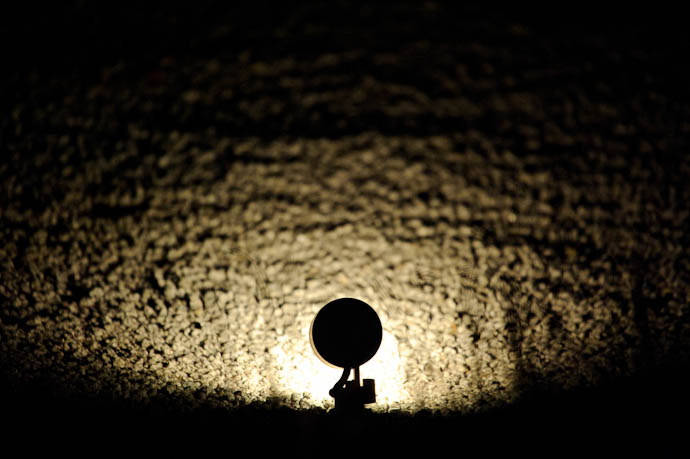
Nikon D700 + Sigma “Bigma” 50-500mm OS @ 500 mm — 1/125 sec, f/6.3, ISO 6400 — map & image data — nearby photos
I posted the picture above, of a spotlight on a rock garden in Kyoto, in my ”Amorphous Wavy Lines Quiz” post last week, asking whether anyone knew the reason for the wavy lines one sees at full resolution:
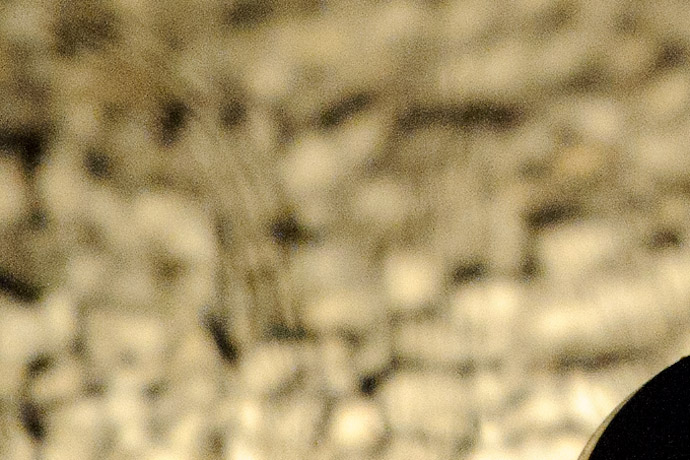
Full-Resolution Crop
of one of many sections of these wavy-line tracks
The answer differs depending on how honest you are with yourself. In my case, the true answer is
“I don't know.”
Being a bit less honest with myself, I'll say
“Likely some kind of diffraction, possibly related to the “discrete points” nature of the image sensor, but I'm not sure”
But if I want to completely fool myself into thinking I understand what's going on here, I'll just say:
“It's caused by grass in the foreground.”
It is caused by the grass in the foreground — that's true — but I don't understand why the grass in the foreground has this effect in this situation.
In this wider, 1/15th second ISO 12,800 shot, you can see a strip of grass in the foreground...
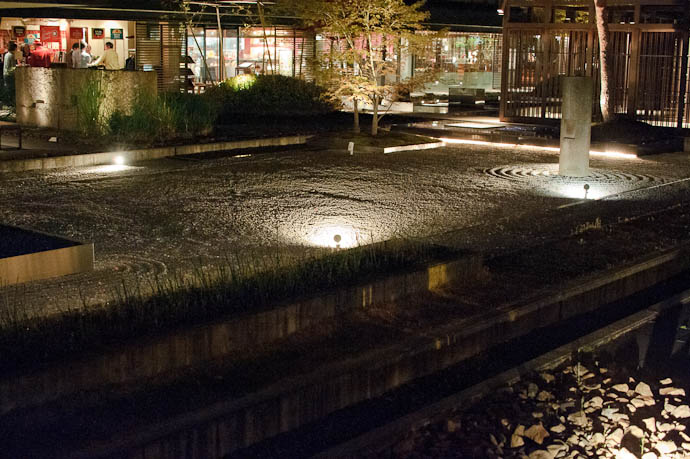
Nikon D700 + Sigma “Bigma” 50-500mm OS @ 50 mm — 1/15 sec, f/6.3, ISO 12800 — map & image data — nearby photos
Restaurant Rock Garden at Night
I've seen this effect a few times. One I recall is from shooting Anthony's cousins Grace and Luke in a boat at my folks' place. The many layers of cattails and trees sometimes made for this freaky (diffraction?) effect:

Nikon D700 + Nikkor 70-200mm f/2.8 @ 200 mm — 1/1000 sec, f/2.8, ISO 200 — map & image data — nearby photos
Cattail
and a good dose of freakiness
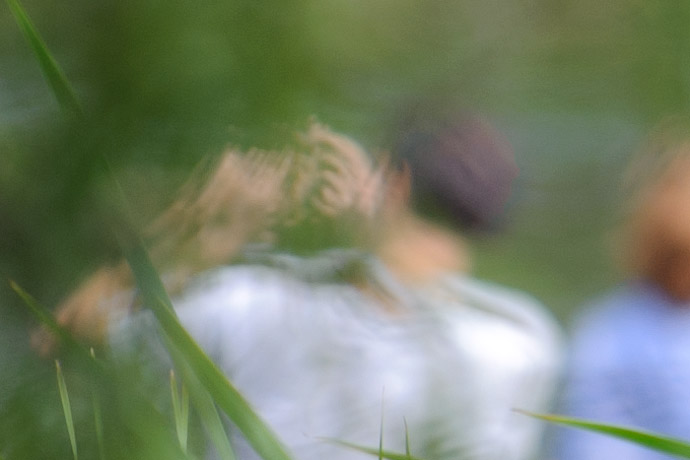
Full-Resolution Crop
( My brother has 6½ fingers on each hand, not 9¾ )
In the quiz, the focus was behind the effect, but in this case, it's in front.
Here's another example...

Nikon D700 + Nikkor 70-200mm f/2.8 @ 200 mm — 1/1250 sec, f/2.8, ISO 200 — map & image data — nearby photos
looks like a
Time-Travel Portal
is in the process of opening
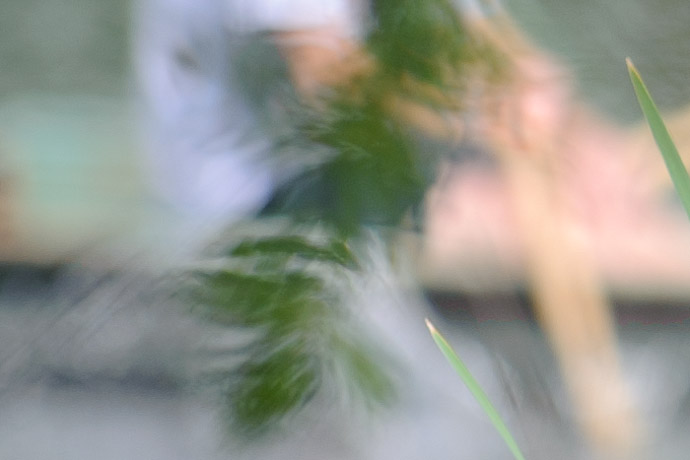
Yet, I take pictures in seemingly-similar situations all the time, and normally don't experience any of these effects....
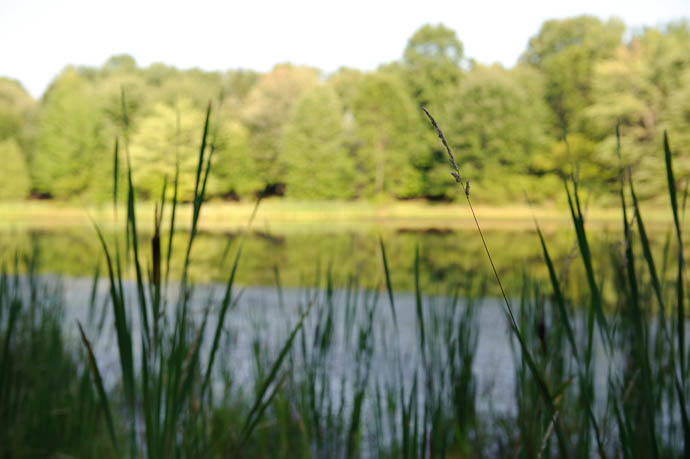
Nikon D700 + Nikkor 24-70mm f/2.8 @ 48 mm — 1/320 sec, f/4.5, ISO 200 — map & image data — nearby photos
“No Time Travel For You”
So if there are any physicists in the house who can explain this, I'd love to understand it, at least enough to be able to predict whether it will/won't happen in a given situation.
Are you sure it’s not hot air causing this effect? Hot light, hot air above grass?
Yes, I’m sure it has nothing to do with temperature-gradient diffraction. Some of the answers along those lines were certainly… uh… “inventive”, though. 🙂 —Jeffrey
I would have originally guessed mirage as well (although it doesn’t really look like mirage), but I suspect this guy hit the nail on the head… it’s an artifact of VR/OS.
I don’t think it has anything to do with VR…. that would be so freaky if it did. —Jeffrey
Any examples of this effect when not at a telephoto focal length?
Hello Jeffrey!
My name is Edgar. I am a physicist, Linux geek, photo geek and Lindy Hop
dancer from Grenoble, in the French Alps. I follow you blog because of
my interest in photography and because I plan to travel to Japan in
spring 2011.
I have a theory for what you are seeing.
In every case you have some grass or some herbs that are obstructing
your view and are way out of focus. Every time you shoot through an
obstruction that is much out of focus, the obstruction acts as an
aperture, and the freaky look comes from the fact that it is a complex
aperture.
I suggest you try the following experiment:
– make an artificial aperture for your lens by cutting a small hole in a
piece of black cardboard
– mount your camera + lens on a tripod and aim at some random subject
– defocus your subject substantially, it does not matter whether you
focus in front or behind your subject as far as it is well defocused
– now look through the viewfinder again, but holding the artificial
aperture in front of your lens: the image will appear darker and less
blurry, that’s because the small aperture increases the depth of field
– move the aperture in front of your lens while looking through the
viewfinder: you will see the subject moving in the viewfinder because
of a parallax effect; the apparent movement will be either in the same
direction or opposite of the aperture movement depending on the sign
of your defocusing
– now make more holes in your piece of cardboard, the holes have to be
close enough that they all fit within the aperture of the lens
– try again with this multi-hole aperture in front of the lens: since
every hole will have a different parallax, you will see multiple images
of your subject (as many as holes) superimposed, that is much like the
effect you are showing here
– if you turn the focusing ring, you will see the multiple images merge
and split as you get into and out of focus.
Now, the reason why you sometimes see this effect and sometimes not is
that you need both a complex obstruction in the foreground and a
defocused subject behind it that has enough structure to make obvious
that there are multiple images superimposed. You also need a lens with a
large physical aperture and a strong defocusing capability, so the
effect is certainly easier to see with your Bigma than with any other of
your lenses.
Best regards,
Edgar.
I’ll definitely give it a try, thanks! —Jeffrey
I think I tend to agree with Edgar, in that I think it’s a function of light diffraction and the perception of this that gets translated into a digital photo through that lens, through the way the camera perceives it, with the focus variation creating some sort of “oasis” effect.
Of course, I know absolutely nothing about photography, but I do know a few things about nuclear magnetic resonance, and the pictures of molecules you can get from such resultant spectra, so I think that I’m learning a lot from your blog.
Good show! And good photos and puzzles. Thanks.
You can also create some cool out-of-focus shape effects with simple cardboard cutouts:
http://www.flickr.com/photos/pure_awesome/4384833940/
Hi Jeffrey,
I guess a nice natural effect of what you experienced can be seen here: pinhole effect. I guess Edgar is the closest in explaining 🙂
Best regards,
Henk, Winnipeg, MB
Hi,
A little follow up on the freaky lines, I got the same in on of my pictures, in broad daylight. You could see it here at the top of the first picture. The grass seems to do the same thing here in Canada as in Japan 😉
From Seattle.
Here is my hypothesis.
I was testing a mirror lens and it is more obvious. When I focused too near the effect went one way and when focusing far the other.
Try focusing close to the corner of a window with an object in the background. Then focus farther and farther until past the object. With a mirror lens looking at a highlight the donut shape will only be 1/4 instead of the full circle. When focusing past the highlight the 1/4 will be on the other side. When on the object no donut.
The mirror lens is wide (77mm filter size) which could add to the effect. With a mirror lens this will show as donuts for spots but for lines it will show a doubling, something I never see mentioned. The surface area at the outer edge is greater and there is no center so the edges of the out of focus line are brighter and the center is absent or dim.
I also focused the mirror lens on the edge of a sign then on the building behind the sign and it was if I were seeing through the sign at the edge.
Maybe this could be proven with lenses of different widths but the same focal length set up with the same intermediate objects. I have not yet tried this with a regular lens but I do have some not sharp but round aperture lenses set aside for the bokeh that could work, one is 300mm. Or better the 82mm filter Sun 190-420mm vs 72mm Sigma 400mm vs 52mm Nikkor 200mm with a doubler.
From above:
“- move the aperture in front of your lens while looking through the
viewfinder: you will see the subject moving in the viewfinder because
of a parallax effect; the apparent movement will be either in the same
direction or opposite of the aperture movement depending on the sign
of your defocusing”
Does the in focus object move? Does the out of focus area move differently per external aperture offset but more total with a wider lens? Or is it just the physical size of the aperture which could be the same for the same focal length?
Also when focusing through a chain link fence with wide aperture to make it less visible might apply here. The fence gets spread so thin as to be less visible. Perhaps wider physical aperture = wider out of focus.